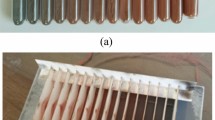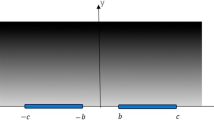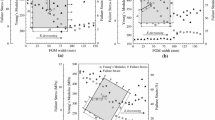Abstract
Quasi-static mixed mode crack initiation and growth in functionally graded materials (FGMs) was studied through fracture experiments on polymer-based FGMs manufactured by selective ultraviolet irradiation poly(ethylene carbon monoxide)—a photo-sensitive copolymer that becomes more brittle and stiffer under ultraviolet irradiation. The objective of the study was to determine whether crack kinking criteria for homogeneous materials, e.g., maximum hoop stress criterion, also hold for FGMs. Single edge notched tension specimens with different spatial variations of Young's modulus, failure stress and failure strain, were tested. Near tip mode mixity was introduced either by inclining the crack to the remote loading direction, as in the case of homogeneous materials, or to the direction of material gradient, or both. A full-field digital image correlation technique was used to measure in real-time the displacement field around the crack tip while it propagated through the graded material, and to extract the fracture parameters of stress intensity factor K I and K II , and the T-stress. It was found that the nonsingular T-stress term in the asymptotic expansion for stresses plays a very important role in accurately measuring fracture parameters. It was also found that the maximum tangential stress criterion can be applied to the case of FGMs to predict crack kinking provided that the effect of the T-stress is accounted for and the process zone size is small compared to the intrinsic material gradient length scale. However, for accurate crack path prediction at a length scale comparable to the material gradient, detailed material property information is required. In general, the crack will propagate towards a region that exhibits less fracture toughness, but, unlike the case of homogeneous materials, along a path where K II is not necessarily equal to zero.
Similar content being viewed by others
References
Erdogan F, Sih GC (1963) On the crack extension in plates under plane loading and transverse shear. J Basic Eng-Trans ASME 85D(4):519–525.
Cotterell B (1965) On the brittle fracture paths. Int J Fract Mech 1(2):96–103.
Gu P, Asaro RJ (1997) Crack deflection in functionally graded materials. Int J Solids Struct 34(24):3085–3098.
Gu P, Asaro RJ (1997) Cracks in functionally graded materials. Int J Solids Struct 34(1):1–17.
Becker TL Jr, Cannon RM, Ritchie RO (2001) Finite crack kinking and T-stresses in functionally graded materials. Int J Solids Struct 38(32–33):5545–5563.
Kim J-H, Paulino GH (2003) T-Stress, mixed-mode stress intensity factors, and crack initiation angles in functionally graded materials: a unified approach using the interaction integral method. Comput Methods Appl Mech Eng 192(11–12):1463–1494.
Chao YJ, Liu S, Broviak BJ (2001) Brittle fracture: variation of fracture toughness with constraint and crack curving under mode I conditions. Exp Mech 41(3):232–241.
Smith DJ, Ayatollahi MR, Pavier MJ (2001) The role of Tstress in brittle fracture for linear elastic materials under mixed-mode loading. Fatigue Fract Eng Mater Struct 24(2):137–150.
Rousseau C-E, Tippur HV (2000) Compositionally graded materials with cracks normal to the elastic gradient. Acta Mater 48(16):4021–4033.
He M-Y, Hutchinson JW (1989) Kinking of a crack out of an interface. J Appl Mech-Trans ASME 56:270–278.
Abanto-Bueno J, Lambros J (2005) Parameters controlling R-curves in functionally graded materials under mode I loading. Int J Solids Struct (In press).
Williams JG, Ewing PD (1972) Fracture under complex stresses—the angled crack problem. Int J Fract 8(4):416–441.
Andrady AL (1990) Weathering of polyethylene (LPDE) and enhanced photodegradable polyethylene in the marine environment. J Appl Polym Sci 39(2):363–370.
Lambros J, Santare MH, Li H, Sapna GH III (1999) A novel technique for the fabrication of laboratory scale model functionally graded materials. Exp Mech 39(3): 184 –190.
Ivanova E, Chudnovsky A, Wu S, Sehanobish K, Bosnyak CP, Wu S (1996) A new experimental technique for modeling of a micro-heterogeneous media. Exp Tech 20(6):11–13.
Li H, Lambros J, Cheeseman BA, Santare MH (2000) Experimental investigation of the quasi-static fracture of functionally graded materials. Int J Solids Struct 37(27):3715–3732.
Abanto-Bueno J, Lambros J (2002) Investigation of crack growth in functionally graded materials using digital image correlation. Eng Fract Mech 69(14–16):1695–1711.
Sutton MA, Wolters WJ, Peters WH, Ranson WF, McNeill SR (1983) Determination of displacements using an improved digital image correlation method. Image Vis Comput 1(3):133–139.
Bruck HA, McNeill SR, Sutton MA, Peters WH III (1989) Digital image correlation using Newton–Raphson method of partial-differential correction. Exp Mech 29(3): 261–267.
McNeil SR, Peters WH, Sutton MA (1987) Estimation of stress intensity factor by digital image correlation. Eng Fract Mech 28(6):101–112.
Eischen JW (1987) Fracture of nonhomogeneous materials. Int J Fract 34(1):3–22.
Delale F, Erdogan F (1983) The crack problem for a nonhomogeneous plane. J Appl Mech Trans ASME 50(3):609–614.
Abanto-Bueno J, Lambros J (2005) Experimental determination of cohesive failure properties of a photo-degradable copolymer. Exp Mech 45(2):144–152.
Kandula SSV, Abanto-Bueno J, Geubelle PH, Lambros J (2005) Cohesive modeling of dynamic fracture in functionally graded materials. Int J Fract 132:275–296.
Author information
Authors and Affiliations
Corresponding author
Rights and permissions
About this article
Cite this article
Abanto-Bueno, J., Lambros, J. An Experimental Study of Mixed Mode Crack Initiation and Growth in Functionally Graded Materials. Exp Mech 46, 179–196 (2006). https://doi.org/10.1007/s11340-006-6416-6
Received:
Accepted:
Published:
Issue Date:
DOI: https://doi.org/10.1007/s11340-006-6416-6




